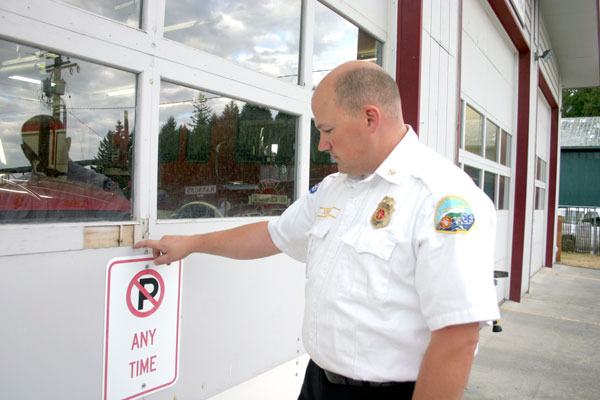In a most unceremonious way, the old aerial apparatus from the Bayview fire station is now a junker at Island Recycling in Freeland.
The elevated hose stream truck was the only engine of its kind on South Whidbey. Though not the kind with a ladder and a bucket for high rescue, it was built to douse flames higher than two stories.
At more than 30 years old, however, its repair costs began to burden the $2.3 million budget for South Whidbey Fire/EMS to the tune of $16,000-$18,000 annually over the past few years.
“It just got to a point where we couldn’t afford to fix it,” said Fire Chief Rusty Palmer.
The inability to repair or upgrade equipment and stations is a common problem and frustration for the South End’s firefighters. Over the past two years, South Whidbey Fire/EMS has cut $1.6 million from its expenses — a mechanic, fire engines, delayed station upgrades — and led the three fire commissioners to seek a 15-cent levy increase this November.
Now, South Whidbey’s fire protection district, from Freeland to Clinton, relies on an agreement with the Oak Harbor Fire Department for its aerial apparatus. In an emergency, it would take more than 30 minutes for the ladder truck to reach the South End, if it’s available. Admittedly, there is only a handful of buildings taller than two stories.
“We don’t have a lot of those buildings,” Palmer said.
“Often times we need the truck for the extra reach.”
Deputy Chief Jon Beck said frontline pumpers like the aerial apparatus have a service life of about 15 years. South Whidbey Fire/EMS doubled its elevated hose truck’s life, until it failed pump-and-ladder tests and began to cost too much money and time for custom replacement parts.
“We kept it absolutely as long as we could,” Beck said.
Stretching equipment and vehicle service life is common for the South End’s fire protection district. Part of the problems that come with making gear last longer than expected is after 20 years, regulations and needs change. Older trucks pumped at 1,000 gallons per minute, while newer ones gush at 1,500 gallons per minute.
“They don’t meet the demands that we have any more,” Beck said. “Houses have gotten larger.”
The loss and inability to replace the truck is just part of almost $1.7 million South Whidbey Fire/EMS cut the past two years. Money to buy a new one, valued at $750,000, just doesn’t exist in the fire district’s coffers.
Part of the issue, Palmer said, is that it makes more sense to replace the aerial apparatus with what is called a “quint,” a quintuple-use truck that has a ladder, hose, water storage, pump and a compliment of 10 ground ladders. Basically, a quint is five trucks in one, which reduces the number of overall engines the district would need, Palmer explained.
Training for the dominantly volunteer firefighter and emergency medical technician staff was also reduced. Salaried and volunteer emergency responders from South Whidbey were sent to Oak Harbor or the state academy in North Bend in the past. The cost to send a few people at a time became too much in the modern economy.
“We just don’t have money to do that,” Palmer said. “We’ve had to cut back on the away, off-island teachings.”
South Whidbey Fire/EMS is a tax-funded service. Annual property taxes currently valued at 61 cents per $1,000 of assessed property value, combined with an aggressive capital savings plan at 25 percent of all revenue, helped the district stay ahead of the housing market crash.
That was, until it didn’t.
A couple of years ago, Palmer evaluated the district’s budget forecast and projected that by 2014, its expenses would surpass its revenue. While some companies may take on the debt, South Whidbey Fire/EMS commissioners have been proud to be debt-free for years, which was aided by its abundant capital project savings for fire engines and stations. To help stable the district’s finances as property values on South Whidbey sag, the fire commissioners are seeking a 15-cent levy increase on the November ballot. If approved, the increase would push the total to 76 cents per $1,000 of assessed property value, or about $190 annually for a $250,000 property.
“We’re anticipating that revenues will go down,” Palmer said.
One of the items that fell to the cutting room floor was a long-planned new station in Bayview, along with a training facility. The multi-million dollar station was proposed back in the boom-time economy of the late 1990s, and was to be built between Good Cheer Food Bank and Bayview School, which gave the responders better access to Highway 525 and into Langley. It was just one of many station plans that were scrapped.
Recently, plans for new paint, bay doors, lighting and carpet were set back after asbestos was found in the Bayview and Maxwelton stations – two of the oldest in the district. About $56,000 originally meant to beautify the station is now set for asbestos abatement, in addition to about $67,000 moved from the capital fund to operational to cover asbestos removal at the Maxwelton station. While the ceilings and walls were being cleaned, the fire commissioners and chief deemed it as good of a time as any to at least replace the carpet and lights, which needed to be removed or torn out anyway.
The uncertainty of South Whidbey Fire/EMS’s financial future has Palmer and the station captains crafting “companion” budgets for the coming fiscal year — one with the levy approval, one without.



